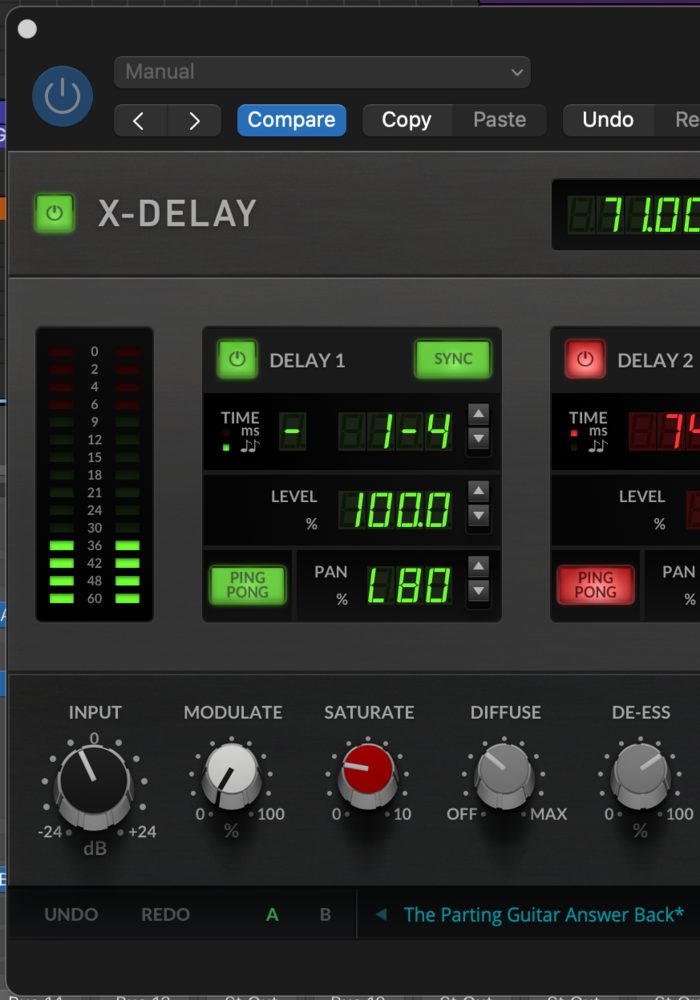It doesn’t seem too long ago I was writing a review of SSL’s rather good Native X-Echo plug-in. Now they’re updating the plugin range with a take on those original digital studio delays of the ‘80s with the X-Delay, a versatile multi-tap digital delay. Will we be able to revisit the time of the AMS DMX 15-80s, hear the distant chimes from the Deltalab DL-4 and DL-2, hear the golden decades sound of the Lexicon PCM41 and PCM51 or the Roland SDE200 thrown back at us? Only time will tell.
Starting with the UI, it is well laid out and allows you to get started right away. The top centre box contains the master delay time in BPM. You can sync this to your song or project by lighting the HOST button green. If not, the BPM will turn red and you can either adjust with the up down arrows or tap in something random using the TAP TEMPO button. Using the MULTI button is a quick way to double or halve your tempo.
There are up to four configurable taps for each preset. How many of them you use is up to you but four gives you immense scope for creating some unbelievably lush soundscapes. Each tap can be switched in or out. In green it is a synced tap and un-synced, it displays red and the tap is considered to be in FREE mode. When green, the delay time is set as a musical note. In FREE mode (red) the TAP TIME is set as a simple millisecond value. The next three parameters are common to both red and green, (FREE/SYNC) modes. TAP LEVEL controls the volume of the tap as a percentage value. PING PONG moves the tap around the stereo field within the range you specify. So, if for example you have started with a hard pan to either left or right, the tap will move around the centre with random values up to the hard pan.
In the lower section of the GUI are the global controls, which affect all of the taps in equal measure. Firstly, to the left there’s the input gain pot providing ±24 dB, above which is the input level meter in dBFS. Next to this is the MODULATION pot, which by means of an LFO speeds up and slows down the delay time by varying the amplitude. Next is the SATURATION pot, adding a varying amount of smooth analogue clipping and harmonic dirt to the delays.
Next is the DIFFUSION pot, which sounds the same as the version on the Native X-Echo. This adds an increasing, room type reverb which helps to blend your delays without having to add aux busses and build plugin chains.
Lastly but by no means least in this first global control section is a DE-ESSER, which reduces sibilant and aggressive high frequencies. Lower middle is the FEEDBACK control, which as always feeds a varying amount of the delays back to the input signal on a scale of 0-50%. Any value over 100% is feeding more delay level back to the input and is leaving the output, so this can create a swell of sound and level very quickly. Add in the FREEZE button and you can build rises, hit the KILL button and create the drop all in real-time. The combination of controls in the feedback section are very musical and lend themselves to creativity and experimentation.
To the right are some controls designed to help your delay effects sit better in your mix. This section starts with high and low pass filters for shaping the sound and filtering out low end rumble or overly aggressive highs, followed by the WIDTH, which is a mid/side control pot with a percentage value from 0-200%. 100% sounds like straight stereo, while 200% is wide and can sound a little phasy, depending on the source signal being fed.
I find myself with a big grin on my face when I think back to the thousands of pounds worth of vintage digital rack units this one plugin surpasses, not only in terms of flexibility but in sheer processing power and delay lengths alone. So, if you want a plugin that gives a huge nod to the past but has plenty to brighten up your future, go and check this out. What the X-Echo does for tape Echoes, this does in bucket loads for digital delays.



